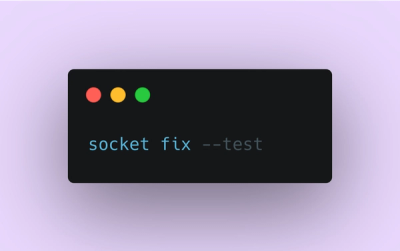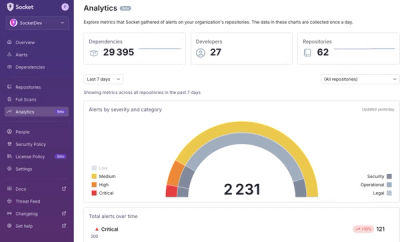
Product
Introducing Socket Fix for Safe, Automated Dependency Upgrades
Automatically fix and test dependency updates with socket fix—a new CLI tool that turns CVE alerts into safe, automated upgrades.
@coursekit/client
Advanced tools
CourseKit is the easiest way to create a full-featured, custom online course, exactly how you want it. Use your favorite frontend tools - no server required!
This repo is for the CourseKit JavaScript Client which provides an easy way to access the features of the CourseKit API.
NPM:
npm install --save @coursekit/client
There are two classes you can use from this library, Lesson and User. Both an ES Modules and CommonJS build are provided.
ESM:
import { Lesson, User } from '@coursekit/client'
CJS:
const { Lesson, User } = require('@coursekit/client')
The User class is used to create a User object.
const { User } = require('@coursekit/client')
const user = new User()
The constructor takes one parameter:
options?: object. An optional object with the following options:| Option name | Required? | Type | Description |
|---|---|---|---|
| baseUrl | no | string | Changes the URL of the CourseKit API. |
load(): Promise<User>Loads the user's data from the API. The return object properties are:
status: number. The status of the API call to load the user.| Status | Description |
|---|---|
| 200 | Successfully loaded |
| 401 | User is not authenticated |
| 500 | Error |
user: User. An object which provides the data and methods you need to manage the user.Example:
const { User } = require('@coursekit/client')
const { status, user } = new User.load()
if (status !== 200) {
console.log(user.getName()) // null
} else {
console.log(user.getName()) // Kilgore Trout
}
The User object, returned from the load method of User class, provides an easy way to manage the user from the client.
login(opts: object): voidRedirects the user to the login form. Note that you must supply an options object with either a courseId value or a schoolId value. This value will be used to determine where the user is redirected after login. If both values are provided, the courseId will be used.
Example:
// Redirects to login form then to homepage of school
user.login({ schoolId: 'sc8gn2pl' })
| Option name | Required? | Type | Description |
|---|---|---|---|
| courseId | no | string | The ID of the course that the user should be redirected to after login. |
| schoolId | no | string | The ID of the school that the user should be redirected to after login. |
Will do nothing if the user is already logged in.
logout(opts: object): voidLogs out the user. Note that you must supply an options object with either a courseId value or a schoolId value. This value will be used to determine where the user is redirected after logout. If both values are provided, the courseId will be used.
| Option name | Required? | Type | Description |
|---|---|---|---|
| courseId | no | string | The ID of the course that the user should be redirected to after logout. |
| schoolId | no | string | The ID of the school that the user should be redirected to after logout. |
Will do nothing if the user is not logged in.
isAuthenticated(): booleanReturns a boolean indicating whether or not the user is logged in.
getName(): string | nullReturns the user's name as a string or null if the user is not logged in.
markComplete(courseId: string, lessonId: string): Promise<boolean>Asynchronous method that marks a specified lesson of a course as complete. Returns a promise that resolves to a boolean indicating success. Always returns false if user is not logged in.
markIncomplete(courseId: string, lessonId: string): Promise<boolean>Asynchronous method that marks a specified lesson of a course as incomplete. Returns a promise that resolves to a boolean indicating success or failure. Always returns false if user is not logged in.
isLessonComplete(courseId: string, lessonId: string): boolean | nullReturns a boolean indicating whether or not a user has marked a specified lesson of a course as complete. Returns null if user is not logged in.
isCourseEnrolled(courseId: string): boolean | nullReturns a boolean indicating whether or not a user is enrolled in a specified course. Returns null if user is not logged in.
getNextLessonId(courseId: string): string | nullReturns the lesson ID of the next incomplete lesson of a specified course or null if the user is not logged in.
getProgress(courseId: string): float | nullReturns a number between 0 and 1 with decimal points indicating the amount of the specified course that is complete. For example, in a 4 lesson course if 1 lesson is complete this method would return 0.25.
Returns null if the user is not logged in.
The Lesson class is used to load lesson content.
const { Lesson } = require('@coursekit/client')
const lesson = new Lesson(courseId, lessonId)
The constructor takes three parameters:
courseId: string. The ID of the course.lessonId: string. The ID of the lesson.options?: object. An optional object with the following options:| Option name | Required? | Type | Description |
|---|---|---|---|
| baseUrl | no | string | Changes the URL of the CourseKit API. |
loadPlayer(targetSelector: string, opts?: object) : Promise<object>To display your lesson video on your site, the loadPlayer method will embed an HTML5 video player into your page. It also returns a Player object which provides methods and events that allow your site to interface programmatically with the player.
You will need to elect a "mount element" in your page where the player will be dynamically embedded. e.g.
<!--Mount element where video player will be embedded-->
<div id="video"></div>
The parameters are:
targetSelector: string | Element a CSS selector targeting the DOM element in which you want to create the player (eg. "#target"), or the DOM element itselfopts?: object. an object containing the player options. The available options are:| Option name | Required? | Type | Description |
|---|---|---|---|
| autoplay | no (default: false) | boolean | start playing the video as soon as it is loaded |
| hideControls | no (default: false) | boolean | the controls are hidden |
| showSubtitles | no (default: false) | boolean | the video subtitles are shown by default |
The return object properties are:
status: number. The status of API call to load the lesson's video.| Status | Description |
|---|---|
| 200 | Successfully loaded |
| 401 | User is not authenticated |
| 403 | User is authenticated but does not have access to this lesson |
| 500 | Error |
player: Player | null. An instance of the Player object that provides methods and events allowing you to control the video player with JavaScript. Note that the player will be null if the status is not 200.Example:
const { status, player } = await lesson.loadPlayer('#video')
if (status !== 200) {
// player === null
} else {
player.addEventListener('play', console.log('Video is playing!'))
}
loadContent() : Promise<Content>Loads private content from the Lesson API.
The Content object properties are:
status: number. The status of API call to load the lesson's content.| Status | Description |
|---|---|
| 200 | Successfully loaded |
| 401 | User is not authenticated |
| 403 | User is authenticated but does not have access to this lesson |
| 500 | Error |
content: string | null. The content string or null if the API call was not successful.Example:
const { status, content } = await lesson.loadContent()
if (status !== 200) {
// content === null
} else {
console.log(content) // This is private lesson content!
}
This object is returned from the loadPlayer method of the Lesson. The object is an instance of the api.video PlayerSDK class.
Since the Player object is an instance of the of the api.video PlayerSDK, you should check the documentation of the PlayerSDK methods for information about methods and events.
Note that you'll need to be able to access the school ID, course IDs, and lesson IDs in your app so that you can request the relevant resources. These are all public values so feel free to hardcode these.
One strategy that's effective for static sites and single-page apps is to hardcode the school ID directly in your code, e.g. const schoolId = 'scx7fdv32m', and generate page routes with the course and lesson IDs as dynamic segments.
For example, your lesson page may be /courses/:courseid/lessons/:lessonid. Now, it's trivial to retrieve the course ID and lesson IDs at runtime.
const segments = window.location.pathname.split('/')
const courseId = segments[segments.length - 3]
const lessonId = segments[segments.length - 1]
This code will load the user from API and should be run ASAP.
const { User } = require('@coursekit/client')
const { status, user } = await new User.load()
Put an HTML button somewhere on your page (e.g. in the nav bar) where a user can log in or out.
const button = document.querySelector('#login-button')
if (user.isAuthenticated()) {
button.innerText = 'Log out'
button.addEventListener('click', user.logout({ schoolId }))
} else {
button.innerText = 'Log in'
button.addEventListener('click', user.login({ schoolId }))
}
On your lesson page you probably would include a button that will allow the user to simultaneously mark the current lesson complete and progress to the next one.
const button = document.querySelector('#complete-button')
if (user.isAuthenticated()) {
button.addEventListener('click', async () => {
const success = await user.markComplete(courseId, lessonId)
if (success) {
const nextLessonId = await user.getNextLessonId(courseId)
window.location.href = `/courses/${courseId}/lessons/${nextLessonId}`
}
})
}
If you want to include private text-based content in your course you may want use a markdown string. You can load it from the API and convert to HTML using a library like MarkdownIt. Once that's done you can add it to the page.
const { Lesson } = require('@coursekit/client')
const MarkdownIt = require('markdown-it')
const lesson = new Lesson()
const { status, content } = await lesson.loadContent()
const md = new MarkdownIt()
const display = document.querySelector('#display')
if (status === 200) {
display.innerHTML = md.render(content);
}
if (status === 401) {
display.innerHTML = 'You\'ll need to log in or enroll to access this lesson.'
}
if (status === 403) {
display.innerHTML = 'You\'ll need to enroll to access this lesson.'
}
if (status === 500) {
display.innerHTML = 'There was an error loading this lesson, try again later.'
}
TBA
FAQs
CourseKit client library
The npm package @coursekit/client receives a total of 5 weekly downloads. As such, @coursekit/client popularity was classified as not popular.
We found that @coursekit/client demonstrated a not healthy version release cadence and project activity because the last version was released a year ago. It has 1 open source maintainer collaborating on the project.
Did you know?

Socket for GitHub automatically highlights issues in each pull request and monitors the health of all your open source dependencies. Discover the contents of your packages and block harmful activity before you install or update your dependencies.

Product
Automatically fix and test dependency updates with socket fix—a new CLI tool that turns CVE alerts into safe, automated upgrades.

Security News
CISA denies CVE funding issues amid backlash over a new CVE foundation formed by board members, raising concerns about transparency and program governance.

Product
We’re excited to announce a powerful new capability in Socket: historical data and enhanced analytics.